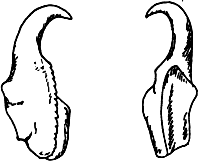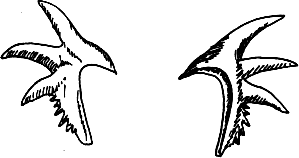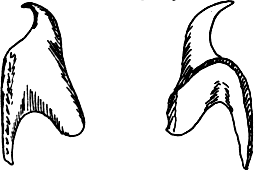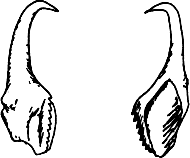Introduction
The rock strata of the Cincinnatian Series contain many little known fossils. There is still much to learn about the fauna of the Late Ordovician period. There are quite a few common genera in the Cincinnati rocks that have not been very well studied or classified by professional paleontologists and have been overlooked by amateurs because specimens are not found in most books or are too small to be noticed. One such group the Scolecodonts. Scolecodonts are the hard jaws of polychaete worms. They are very common in many rock layers in the Cincinnati area but are quite small. Only a millimeter or two in length, these fossils are most often jet black and stand out from the surrounding matrix when examined with a hand lens or microscope. They are also made of a harder material than the surrounding limestone, shale and minerals so they can be easily removed with acid.
This Web page is designed to help you identify these tiny, little understood fossils. With it, you will be able to collect and identify these interesting and scientifically valuable specimens.

Here is a collection of drawings and descriptions of some of the more common Scolecodont genera found in the Upper Ordovician formations of Cincinnati.

Arabellites: Prominent, edentulate falx; straight dentary occupies posterior half of the jaw. Posterior end is truncate; "wrinkles" on the outer margin.

Colpogenys: Triagular, dentary along longest side, anterior and lateral margins form a short, anteriorly directed ramus. Posterior is broadly rounded to truncate; dentary somewhat curved ("S") with well developed anterior tooth.

Cornugenys: Oval jaws with lateral ramus and stongly developed first denticle, forming a recurved falx. And edentulate region is followed by one or two large denticles, followed by a series of smaller backward directed denticles. Smaller denicles may occupy space between the larger ones.

Croneisigenys: Slender jaws with oval outline, a stout, well-developed falx and a lateral ramus which encloses a deep bight; usually occur as right jaws.

Diopatraites: Consists of a flat frontal plate, usually "toothed," followed by a tapering shaft.

Drilonereisites: Characterized by a large falx or primary denticle, as long or longer than the jaw; a short ridge of nearly equal sized, backward directed teeth lie along the inner margin.

Leodicites: Cresent-shaped jaws in which the ramus is a smooth continuation of the anterior margin; no fang or falx present; ramus is almost perpendicular to the dentary and is situated in the anterior half of the jaw.

Lobogenys: Elongate and oval; dentary curved outward (right hand) near the anterior; inner face concave; broad ramal extension near the center enclosing a deep bight; ramus perpendicular or acute to dentary.

Nereigenys: Elongate, left jaws, with a strong hook and a truncate posterior end; outer margin more or less convex; dentary straight, extending far onto the falx.

Oenonites: Jaws with a more or less curved anterior hook, followed by a series of smaller teeth.

Paleoenonites: Rectangular shape with a forward directed ramus enclosing a sinus in the anterior margin; posterior margin is truncate; first denticle is somewhat forward directed; denticles may be blunt.

Protarabellites: Broad jaws (left hand) with laterally extended inner and outer margins, dentary curved outward anteriorly with a prominent fang; posterior end tapers or rounded.

Rhamphegenys: Small jaws, usually slightly curved and beak-shaped; consist of a single denticle.

Siluropelta: Relatively flat, no dentary. These are jaw carriers or supports.
![]()
Staurcephalites: Flat to slightly curved jaws with comb-like teeth and anterior margin slanted back toward denticles; outer margin usually consists of squamate material.
Scolecodont - Any jaw element of a fossil polychaete worm.
Anterior end - The forward end of the jaw, usually indicated by the presence of a large falx or fang. The denticles usually point away from the anterior end.
Anterior margin - The front edge of the jaw.
Apparatus - All or part of the scolecodont elements of a single animal, existing in the orginal positions, relative to each other.
Bight - A concavity in the outer margin of the jaw, open to the posterior.
Carriers - Paried elements in the apparatus, occurring behind the forceps and serving as support for their posterior ends.
Dentary - Series of denticles along the top or inner margin. In some forms there are few, if any, denticles present.
Denticles - The individual tooth-like projections on the top margin of the jaw.
Face - Lateral side, either inner or outer, between the margin and the dentary.
Falx - Sickle-shaped extension of the anterior portion of the jaw, usually forming a hook or fang.
Fang - Poorly developed falcal hook.
Length - largest dimension of a jaw parallel to the median axis.
Myocoele opening - Outline of the under side opening into the hollow cavity of the jaw, created for the muscle attachment.
Posterior end - The rear end of the jaw, away from the largest teeth.
Ramus - Any narrow lateral extension of the face of the jaw.
Sinus - Cavity of the anterior margin, usually produced by an anteriorly directed ramus.
Width - Largest dimension of the jaw perpendicular to the dentary.
![]()
Related Topics
![]()
Back to Dry Dredgers Home Page
The Dry Dredgers and individual contributors reserve the
rights to all information, images, and content presented here. Permission to
reproduce in any fashion, must be requested in writing to admin@drydredgers.org.
www.drydredgers.org is designed and
maintained by Bill Heimbrock.